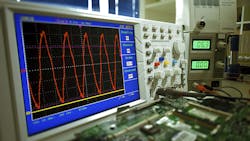VNAs Prove to be Essential Tools for 5G Communications
Download this article in PDF format.
Vector network analyzers (VNAs) are general-purpose measurement instruments that can be used in a wide variety of applications. A perfect example is exemplified in their role in the 5G space, which has become hotbed of activity for VNAs. Figure 1 presents a basic description of a 5G communication system.
To achieve the data rates desired for 5G communications, it is critical that the channels through which the data is passed do not constrain or degrade the data rate. While the information being conveyed is digital, the signals are fundamentally analog. As data rates increase, analog behavior becomes more critical.
VNAs are excellent tools for measuring signal integrity and diagnosing issues when data rates fall short of expectations. For example, VNAs are good for analyzing real-world channel defects, like exceeded tolerances on printed-circuit-board (PCB) artwork, as well as plating and dielectric thickness variations. They are able to evaluate connector performance, construction, and how well connectors are mounted. VNAs can also analyze multi-layer PCB stackups and find imperfect vias or ground-plane issues.
Converting frequency measurements to the time domain, VNAs can even measure the distance to a fault to pinpoint where issues occur. Some VNAs, such as the Anritsu ShockLine MS46500B series, offer an Advanced Time Domain option that enables signal-integrity engineers to measure parameters such as time-domain reflection (TDR), time-domain transmission (TDT), and crosstalk. Furthermore, these analyzers are able to display an eye diagram based on simulated data being transmitted over a measured channel.
To move the massive amounts of data traffic expected in 5G communication systems between data centers and base stations, digital signals will often be converted from electrical to optical signals and back. VNAs can be used to help determine the efficiency at which these conversions happen. When combined with a well-characterized optical modulator or photodiode, VNAs can determine the transfer function of optical transmitters, receivers, and transceivers, including key parameters such as bandwidth, flatness, phase linearity, and group delay.
Testing 5G Base-Station Components
At the base station, unparalleled performance will be required of 5G radios and their RF components. Getting the most out of these components requires a deeper understanding of their behavior. VNAs are used to make measurements as early in the design process as the wafer stage, where S-parameter measurements can be conducted on devices to ensure expected performance or build device models.
Wafer-level measurements pose a unique set of challenges—VNAs need to de-embed the effects of fixtures and probes that enable the measurements. More accurate models lead to shorter design cycles as everyone races to be the first to offer 5G radio solutions. VNAs that cover frequency ranges from 70 kHz to 145 GHz in a single coaxial connection and utilize a wide range of standard embedding/de-embedding techniques allow signal-integrity engineers to realize the most accurate device models.
Lower-Cost Solutions
Among the performance requirements being placed on 5G radios is the need to handle much wider bandwidths, requiring radios to operate at higher frequencies than traditional communication systems. The move to microwave and millimeter-wave frequencies will require many more cell sites to account for the greater path losses at these frequencies.
Combined with historically more expensive microwave and millimeter-wave instrumentation, there is a need for dramatic reductions in cost for measurement equipment, such as VNAs. As a result, dedicated cost-effective VNAs have emerged (Fig. 2). It addresses a market need by offering an unprecedented price point for an E-band VNA, covering frequencies from 55 to 92 GHz in an instrument ready to use right from the box for mass production of E-band components.
The last stage performed by 5G communication systems is the transmission of microwave and millimeter-wave signals to the devices that will utilize them. To achieve 5G’s required data rates, many infrastructure companies are employing multiple-input, multiple-output (MIMO) technologies with antenna systems employing large numbers of array elements, known as massive MIMO. This poses challenges for VNAs, which have been historically used to characterize antenna systems.
The geometries associated with microwave and millimeter-wave components are much smaller than traditional RF components. This makes it difficult to do connectorized measurements, forcing companies to instead perform over-the-air (OTA) measurements. Combined with the large number of array elements and the significantly greater path losses at the high frequencies, the VNAs used to characterize the antenna systems must be much smaller and account for the multiple array elements.
To address this issue, there has been an emergence of small microwave/millimeter-wave measurement modules tethered to a base VNA model to get closer to the devices-under-test (DUTs). One such module is shown in Fig. 3—it enables measurements up to 145 GHz and is about the size of a deck of playing cards.
Leveraging New Technology
To address the numerous aforementioned challenges facing VNAs and the world of 5G, VNA suppliers must take advantage of innovative technologies. For example, Anritsu’s application of nonlinear-transmission-line (NLTL) technology in vector network analysis and other test instrumentation has proven to provide high performance, robust, frequency scalable, and cost-effective test solutions.
NLTL technology redefines the level of performance and size of instrumentation while lowering the cost usually associated with high frequency test and measurement equipment, helping to usher in the next wave of microwave/millimeter-wave instruments. It accelerates next-generation product development and lowers production costs with the portability to install and maintain next-generation radio systems.
VNAs are an essential tool for enabling 5G communication systems. They can be used in applications ranging from data-center signal-integrity measurements, through characterization of the devices and components incorporated in fiber connectivity and millimeter-wave radios in next-generation base stations, to OTA measurements required to address massive-MIMO technologies.
Walt Strickler is Product Marketing Manager at Anritsu.




